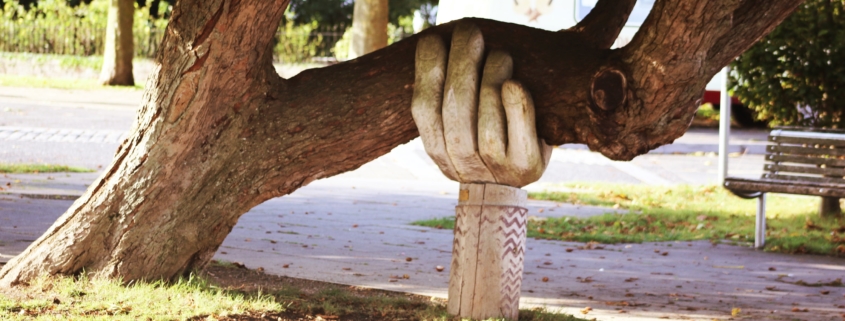Sustaining the “Backbone”
This is a guest post by Elly Brown, Executive Director, San Diego Food System Alliance.
In the Pursuit of Synchronized Impact: Sustaining the “Backbone”
The “Backbone”
A “backbone” organization is a key component of the collective impact model. Conceptualized by FSG, collective impact is based on the recognition that when organizations work together, share resources, and learn from one another, complex problems can be solved more effectively and efficiently. Collective impact is the commitment of a group of actors from different sectors to a common agenda for solving a specific social problem, using a structured form of collaboration. A common analogy used by FSG is the row boat. Imagine a river full of small boats with single rowers headed in the same direction; and now compare that fleet to a long row boat with 24 rowers and a coxswain, swooshing by in synchronized harmony. The 24 rowers aren’t rowing any harder than individual rowers in the small boats but the result is faster and more impactful. In this case, the long row boat and the coxswain is the backbone. The backbone is the critical infrastructure and leadership in pursuit of synchronized impact around complex community-wide issues such as food systems, educational achievement, hunger, childhood obesity, and homelessness.
The organization I am proud to be a part of, San Diego Food System Alliance, strives to be the backbone organization for community food system transformation. The mission of the Alliance is to cultivate a healthy, sustainable, and just food system in San Diego County. We are a diverse and inclusive network of over 150 organizations that works across sectors to promote collaboration, influence policy, and catalyze transformation in the food system. Our organization embraces concepts from both collective impact and movement-building models. Movement-building work is typically focused on political advocacy and power-building, while collective impact generally involves coordinating actions and data as well as advocacy and public education. Both models are focused on systems change.
Challenges to Sustaining the Backbone
To facilitate peer-learning, Impact Cubed convened Leichtag Foundation grantee organizations including San Diego Food System Alliance, San Diego Hunger Coalition, Alliance for Regional Solutions, 211 San Diego, and Community Health Improvement Partners in May and September of 2019. The September meeting included funders with an interest or experience in managing collective impact initiatives.
Based on readings and discussions with peers, it is clear that one of the biggest challenges to collective impact is financing the work. While backbones provide promising opportunities for moving the needle around a complex societal issue, many groups struggle to make a compelling case around the theory of change and desired outcomes while identifying investors with fit, desire, and capacity. Due to the conceptual nature of the backbone function compared to a client-based service delivery model, some funders may misperceive the work as “overhead” or “process”. Sustaining a fully-funded backbone accountable to community-level outcomes requires strategy and entrepreneurial thinking, with continuous R&D.
Timelines also pose a challenge. Moving the needle around a complex societal challenge is a marathon. The community-level impact may actually take a decade to come to fruition. However, philanthropy has traditionally operated on shorter time horizons, typically from 1 to 2 years, possibly 3 years. Due to the shorter time frames, backbones are not able to fully illustrate the community-level impact around the intractable challenges they are trying to address as well as lessons learned candidly. As a result, the shorter-term output and process-based measures reported and stories collected may not fully meet the impact desires of some of the funders.
Opportunities for the Backbone
An article by Strive offered several practical recommendations for financing the backbone including segmenting funding to meet specific needs of the backbone (i.e. data utilization, advocacy, etc), pitching based on outcomes aligned with funder interests, and traditional campaigns. These strategies are definitely worth exploring in detail. However, I believe the larger opportunity for backbones is refining the case and aiming to become “big bettable”. An article in the Stanford Social Innovation Review explains how social change leaders can create more investment opportunities that can transform the world. According to the article, philanthropists are beginning to make more and bigger bets on social change in terms of amount invested. However, 80 percent of philanthropic big bets are currently going to more traditional institutional recipients such as universities, hospitals, and large cultural institutions, not social change organizations. This is due to the perception around lack of “shovel ready” big bettable projects with social change organizations.
There are five elements for success for becoming big bettable: 1) an important problem, 2) a point of arrival, 3) a credible path, 4) a “why philanthropy” rationale, and 5) a strong leader and team. The 2nd and 3rd elements, “point of arrival” and “credible path”, are particularly important to highlight. The “point of arrival” refers to ambitious, concrete, practical, and measurable outcomes that can motivate investors. The “critical path” is a strategic plan to get to the point of arrival, sometimes recognizing the need to lay out a phased approach for identifying, testing, modifying, and expanding potential solutions. For backbone organizations, arriving at these two elements requires sophisticated community-level strategic planning with input from a large number of stakeholders.
The San Diego Food System Alliance is currently at a critical juncture, leading the development of San Diego County Food Vision 2030, a 10-year strategic plan that will guide collective action toward a healthy, sustainable, and just food system in our region. Food Vision 2030 is being developed over 18 months with extensive community and stakeholder input, and will be presented in December 2020 as a common agenda for the next decade. The plan will present high priority goals, objectives, and strategies along with a shared measurement system to track progress over the next decade.
Food Vision 2030 will be our foundation for the “point of arrival” and “credible path” needed to make the case for financing food system transformation in San Diego County. For us, the goal is not only to resource and sustain the backbone, but also to mobilize resources for initiatives aligned with the goals laid out in Food Vision 2030. We are being deliberate in the development of Food Vision 2030 to make our case as strong as possible and become big bettable.
Rise in Various Funding Models
A variety of funding models are emerging to accommodate for the different expectations of system change work. For example, a recent Social Equity Collaborative Fund Climate Justice grant by San Diego Grantmakers and The San Diego Foundation provides “general support” for “grantee’s mission rather than specific projects or programs” and avoids asking for “outcomes”. Instead, the questions around goals are more open below
- What will change as a result of the proposed project and how does that advance racial and climate justice over the long term?
- How will you know you are moving towards the change you specified?
Some funders are also recognizing the need for patient and supportive capital around collective impact, offering longer funding time frames and capacity building assistance. For example, “Advancing a Healthier Wisconsin Endowment” funded $20m for eight years to 10 community coalitions, committed to moving population-level measures (mental and behavioral health) in their regions. In addition to supporting peer convenings with the 10 coalitions for sharing lessons around collective impact, the Endowment provided customized capacity-building support. Additionally, grantees were encouraged to implement a phased approach for identifying, testing, modifying, and expanding potential solutions. This allowed for candid sharing of successes and failures to achieving community-level impact.
Another example mentioned during the facilitated session in September was LA n Sync. Under the umbrella of the California Community Foundation, LA n Sync connects visionary leaders from the academic, government, nonprofit, business, and philanthropic sectors to leverage talent and resources and support Los Angeles organizations applying for funding, spur innovation and attract federal and state dollars to address the critical needs of the region. LA n Sync researches upcoming grants, develops partnerships, provides technical assistance, and helps outside funders build relationships in the region.
These examples are very promising efforts from funders to support system change work and alleviate the potentially time-consuming fundraising work of nonprofits, in the case of LA n Sync.
Being a part of the learning cohort facilitated by Impact Cubed has been a fruitful experience for the San Diego Food System Alliance. We feel confident in the direction we are headed in with the development of San Diego County Food Vision 2030 and revenue diversification. More importantly, we enjoy the opportunity to connect with like-minded system change thinkers to continue our good work ahead of us.


